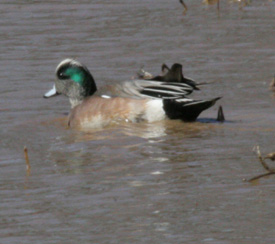American Widgeon
General: The American Widgeon is sometimes called a “Baldpate”  because the white stripe resembles a bald man’s head. The population declined in the 1980’s as a result of drought. Since then they have steadily increased in numbers.
because the white stripe resembles a bald man’s head. The population declined in the 1980’s as a result of drought. Since then they have steadily increased in numbers.
The American Widgeon builds its nest near water. The eggs are creamy white. The chicks hatch in 23-25 days and fledge in 37-48 days.
This bird is known to wait at the surface and steal vegetation from diving ducks as they surface.
Hunters enjoy hunting this dabbling duck, its meat is considered excellent.
Identification: The Widgeon is a decent sized bird roughly 18″ – 23″ with a wingspan of 34″.
Male: The American Widgeon drake has a deep green streak running from its eye to the back of its head. The top of its head is white. its lower face and neck are streaked gray. The back, side and chest are pinkish-brown. In flight the male displays white shoulder patches.
Female and Juveniles: Head appears grayish overall, with finely-blended white and dusky streaks. Breast and flanks are pale reddish-brown; mantle is grayish-brown with some buff barring. Bill is small and grayish, with a black tip.
The American Widgeon is larger than a teal but smaller than a pintail, it’s a medium-size bird, In silhouette, the widgeon can be distinguished from other dabblers by its round head, short neck, and small bill
Habitat: American Widgeons can be found near and on marshes, ponds and shallow lakes. The Pictures here were taken in Spring during their migration north on the Mohawk River in Central New York. They had been feeding in a mowed corn field along with Mallards and Canada Geese.
Territory: Summers throughout most of Canada, Alaska, and the northern third of the United States. Winters along the North American coasts, the southern third of the United States, and Central America.
Diet: American Widgeons eat mostly aquatic plants, upland grasses and legumes. They also eat some insects and mollusks. The American Widgeon’s eats more vegetation than other dabbling ducks.